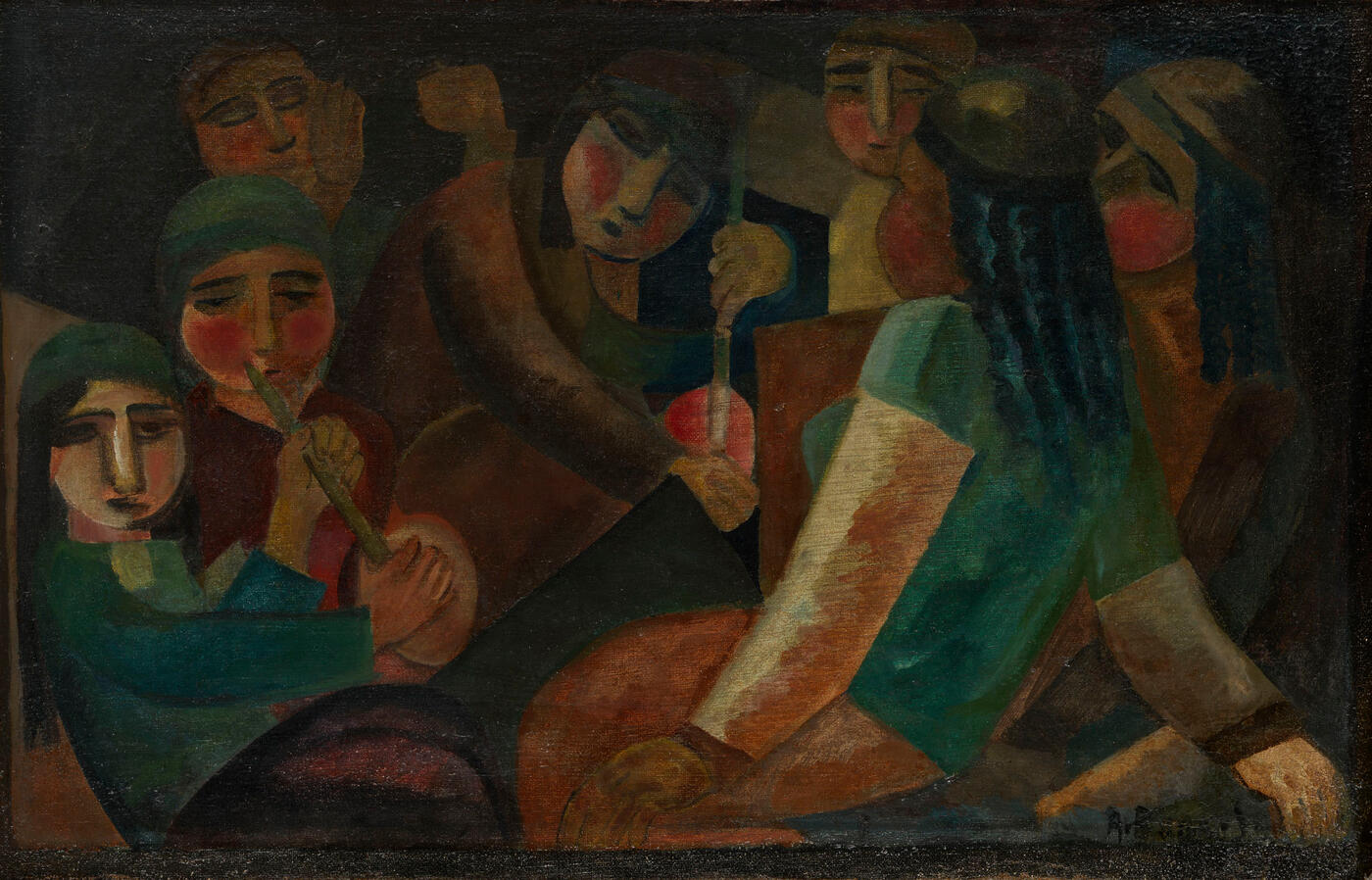25 - 28 November 2012 Russian Art Auctions
25 November 2012

* 16. VOLKOV, ALEKSANDR (1886–1957)
Uzbek Children in a Yurt, signed, with a composition on the reverse.
Oil on canvas, 33.5 by 52.5 cm (image size).
210,000–300,000 GBP
Executed c. 1928–1929.
Provenance: Collection of I.M. Ezrakh, St Petersburg.
Private collection, Europe.
Exhibited: A Time to Gather... Russian Art from Foreign Private Collections, The Russian Museum, St Petersburg, 14 February–12 May 2008.
Literature: Paintings from Private Collections, 18th to 20th Century, St Petersburg, Aurora, 1993, p. 203, illustrated.
Exhibition catalogue, A Time to Gather... Russian Art from Foreign Private Collections, St Petersburg, Palace Editions, 2007, p. 243, pl. 177, illustrated.
Aleksandr Volkov is one of the most outstanding representatives of the “Eastern avant-garde”. His Uzbek images have entered the history of art as bold applications of Cubism, Futurism and Suprematism, with their geometrisation and compartmentalisation of space, to the traditional ethnic types, generic scenes and customs of the East. Uzbek Children in a Yurt, painted circa 1928–1929, belongs to a new phase in the artist’s creative life associated with his exploration of figurative art. Volkov’s works from this period are celebrated for their saturated colour, deep and luminescent use of paint, but also for his personal interpretation based on the combination of traditional styles and folk primitivism with eastern religious motifs, such as Sufism.
In Uzbek Children in a Yurt the artist tackles his favourite subject of music, which he had developed in his well-known masterpiece Listening to Music. Here, the artist portrays a group of young Uzbek girls gathered in a circle, practicing their dutars. By portraying the characters in close-up, Volkov separates them from everyday life and shows their concentration on enjoying the music.
A complex composition is masterfully arranged by the artist: the protagonists are depicted as a single unified group, positioned around the centre, as if seized by the same melody. The background with the girls’ silhouettes forms a distinct decorative compositional structure. The painting, with its rhythm based upon centripetal movement, has a clear conceptual focus: the shining red spherical body of the dutar. Volkov incorporates circles, disks or segments of infinitely varied sizes, colours, positions and angles; they materialize as the base of the yurt, the tambourine, skullcaps, children’s heads, eyebrows, the spheres of girls’ supple breasts or the reddish glow of their cheeks. Each young participant of the round dance is primarily interesting not for her individuality but rather for her contribution to the overall composition.
The seemingly accidental arrangement of the elements of the composition in fact reveals a true unity, confinement of common space, as well as of smaller individual spaces, masses and volumes. Contrasting planes of green robes and dark tones of faces and hands, soft when pushed to the background, on the foreground acquire applique-like thickness. The movement of these flows of colour is polyphonic yet conceptually uniform: from malachite greens, to umbers and ochres, to bright red in the centre of the composition. The fluidity of form and colour underscores the neutral background, with virtually indistinguishable gradations of colour.
This painting is also a summation of Volkov’s artistic quest during the 1920s – a period when his talent truly blossomed. The late 1920s were defined by the birth of the artist’s younger son, Valery. Around this time, Volkov created several genre scenes, as well as portraits depicting young protagonists in their everyday life (Children. Brother and Sister, 1925–1930, and Boy by the Window, 1928). However, in the present work Volkov is consciously avoiding the plethora of oriental sounds and colours, which are featured more prominently in his earlier works, such as Kazakh Girl (1926). The protagonists’ tunics and tubeteikas (traditional Uzbek headcaps), imbued with shadows and coloured highlights, are austere and devoid of a great deal of colour. The conceptual and colour focuses are provided by the shining faces of the girls, flushed with concentration from
playing the dutar, and the dutar itself, its pear-shaped, mulberry-wood body transformed into an immaterial conglomeration of luminous colour.
Moreover, the painting offered here for auction is not merely a genre scene set in a yurt, but rather a metaphorical depiction of the theme of music awakening the human soul. In the 1920s the artist was seized by an interest in folk culture and a sense of affinity with his national heritage. He was captivated by the sounds of the bazaars and provincial streets (Bazaar, 1928; Marijuana Smoker, 1929; Resting, 1926). Ritual and music are at the heart of Central Asian and Islamic culture in all aspects of everyday life, and it is thus music that is the quintessence of his best works of that period.
The fusion of local colour of his native Uzbekistan and experiments in new figurative art that were prevalent in the second half of the 1920s, as well as gentleness and spirituality of the subject matter, render Uzbek Children in a Yurt one of the artist’s most significant works of this period.
Notes on symbols:
* Indicates 5% Import Duty Charge applies.
Ω Indicates 20% Import Duty Charge applies.
§ Indicates Artist's Resale Right applies.
† Indicates Standard VAT scheme applies, and the rate of 20% VAT will be charged on both hammer price and premium.